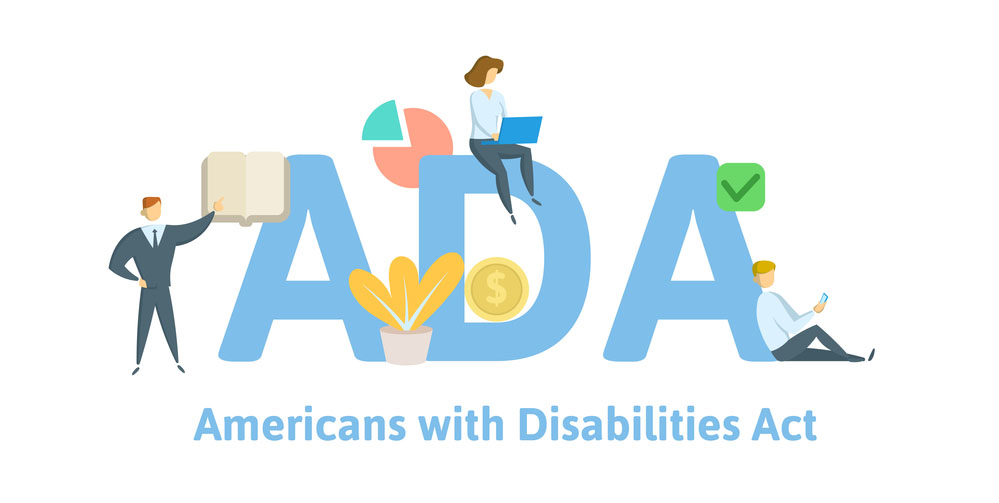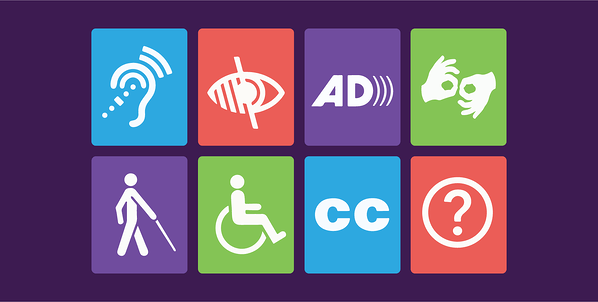We recommend

Does your business fall into these categories?
Title I Compliance
The ADA defines “employer” as any person:
- Engaged in an industry affecting commerce,
- Employing 15 or more full-time employees each working day,
- For at least 20 or more calendar weeks in the year.
This means if your business only has 14 or fewer full-time employees, or is only in business for less than 20 weeks a year, then you do not have to comply with Title I.
Title III Compliance
As far as Title III is concerned, only businesses considered “public accommodations” are required to comply. The federal law offers this non-exhaustive list of public accommodations:
(A) an inn, hotel, motel, or other place of lodging, except for an establishment located within a building that contains not more than five rooms for rent or hire and that is actually occupied by the proprietor of such establishment as the residence of such proprietor;
(B) a restaurant, bar, or other establishment serving food or drink;
(C) a motion picture house, theater, concert hall, stadium, or other place of exhibition or entertainment;
(D) an auditorium, convention center, lecture hall, or other place of public gathering;
(E) a bakery, grocery store, clothing store, hardware store, shopping center, or other sales or rental establishment;
(F) a laundromat, dry-cleaner, bank, barber shop, beauty shop, travel service, shoe repair service, funeral parlor, gas station, office of an accountant or lawyer, pharmacy, insurance office, professional office of a health care provider, hospital, or other service establishment;
(G) a terminal, depot, or other station used for specified public transportation;
(H) a museum, library, gallery, or other place of public display or collection;
(I) a park, zoo, amusement park, or other place of recreation;
(J) a nursery, elementary, secondary, undergraduate, or postgraduate private school, or other place of education;
(K) a day care center, senior citizen center, homeless shelter, food bank, adoption agency, or other social service center establishment; and
(L) a gymnasium, health spa, bowling alley, golf course, or other place of exercise or recreation.
Essentially, any business that regularly serves the public is considered a public accommodation, but private clubs or religious organizations are considered exempt.
Business owners should remember that federal disability law under the ADA is only one part of disability law in any state; there are also corresponding state laws that prohibit discrimination based on disability both in employment and in public accommodations, like California’s Unruh Civil Rights Act.

What do I need to do?
If you fall into one of the categories above that is required to comply, you will need to update your website ASAP to become ADA compliant. This is a very time-intensive process as it has to be done on every unique page with different compliance scanners and typically takes about a week or longer depending on how large your website is.
You may request an ADA Compliance Review performed on your website and we will provide a quote to make your website ADA compliant.
get a quote for ada compliance
Can I update this myself?
Of course. Some items may require advanced knowledge which can be found using a google search and some patience.
Web Accessibility Scanner ADA WordPress PluginHere are some things we discovered the need to be addressed with the ADA compliance scanners:
Add image alt tags on all published images
Add titles to all links, internal and external
Remove links opening up in new tabs or windows
Increase or correct css for h3/h4 tags on section headers and page titles for proper sizing
Correct contrast for text, backgrounds or remove busy or conflicting backgrounds
Buttons, navigation items need to be clear on what they link to
Alter or remove header backgrounds with overlaid text
Adjust overlapping elements
Alter website text colors
Remove All parallax functionality
Remove Holiday Snow Plugins
Remove Image preloading pages or sections
Remove scroll for more options on sections
Remove gloss, bevel on buttons
Remove Instagram feed or re-code
Remove SVG icons
Suspend or update mages or video that flash bright light more than 3 times
Manually embed youtube videos and add iframe titles
Add transcriptions for videos or audio with dialog
Alter website scaling to allow zooming to 500%
Remove Website/Product Search Bars*
Remove custom cart programming*
*You can use a search link to direct users to the search page or the cart page.
Is Your Website ADA Compliant?
- The Americans with Disabilities Act (ADA) requires certain businesses to make accommodations for people with disabilities.
- Web content should be accessible to the blind, deaf, and those who must navigate by voice, screen readers or other assistive technologies.
- Businesses that fall under Title I, those that operate 20 or more weeks per year with at least 15 full-time employees, or Title III, those that fall under the category of “public accommodation,” are covered by the ADA.
- Failure to create an ADA-compliant website could open a business to lawsuits, financial liabilities and damage to your brand reputation.

Which businesses are required to comply with the ADA?
The first thing to understand about the ADA is which businesses are required to comply. Under Title I of the ADA, any business with at least 15 full-time employees that operates for 20 or more weeks every year is covered by the law. Under Title III, businesses that fall into the category of “public accommodation,” such as hotels, banks and public transportation, are also required to comply. That means the entirety of the law applies, from physical considerations to digital accommodations.
If your business falls under either Title I or Title III of the ADA and you do not believe you are compliant, consult with a disability lawyer and explore your options.

Website Accessibility
Accessibility of a website means ensuring that individuals who are visually impaired or hearing-impaired or those who must navigate by voice are still able to meaningfully engage with the content on your website. This can be done in many ways, including some that are not immediately obvious. All in all, totally revamping a website to be ADA compliant could come with a hefty price tag, possibly up to $37,000, but it insulates your business from being targeted by lawsuits.
“A business’s IT department must design its corporate website so that those who are disabled can access it easily,” said Steven Mitchell Sack, an employment law attorney based in Long Island and New York City. “For example, if someone is sight-impaired, the web designer can install certain technologies, such as screen readers, in which a voice reads the text on the screen back to the web visitor. Refreshable Braille text for touchscreens can also be used.”
Here are some common ways businesses address accessibility issues associated with their web content:
- Create alt tags for all images, videos and audio files: Alt tags allow users with disabilities to read or hear alternative descriptions of content they might not otherwise be able to view. Alt tags describe the object itself and, generally, the purpose it serves on the site.
- Create text transcripts for video and audio content: Text transcripts help hearing-impaired users understand the ;content that would otherwise be inaccessible to them.
- Identify the site’s language in header code: Making it clear what language the site should be read in helps users who utilize text readers. Text readers can identify those codes and function accordingly.
- Offer alternatives and suggestions when users encounter input errors: If a user with a disability is encountering input errors because of their need to navigate the website differently, your site should automatically offer recommendations to them as to how to better navigate toward the content they need.
- Create a consistent, organized layout: Menus, links and buttons should be organized in such a way that they are clearly delineated from one another and are easily navigated throughout the entire site.

Liability for failure to comply
Failing to comply with the ADA means your business is susceptible to lawsuits, and it’s common for attorneys to seek out noncompliant businesses both in the physical and digital space. According to Engelhardt, the costs of an ADA lawsuit add up quickly.
“Other than a business being forced to comply, which is costly, the business will have to pay attorneys’ fees, which can be tens of thousands of dollars,” Engelhardt said. “Depending on the state, the business owner can be looking at a $50,000 bill.”
Beyond regulatory consequences, failure to provide accessibility to users with disabilities means losing out on business. If users cannot navigate your website, you might be missing sales opportunities. Further, even if you’re not missing out on sales, ADA compliance makes it easier for search engines to crawl and index your website, pushing it up in the rankings and getting your web content in front of more users.
“If users with disabilities struggle to complete forms and make purchases on your website, you could be losing out on potential customers,” said Laura Ferruggia, senior content creator for Miles Technologies. “Plus, many of the rules for ADA compliance also help websites with search engine optimization.”
